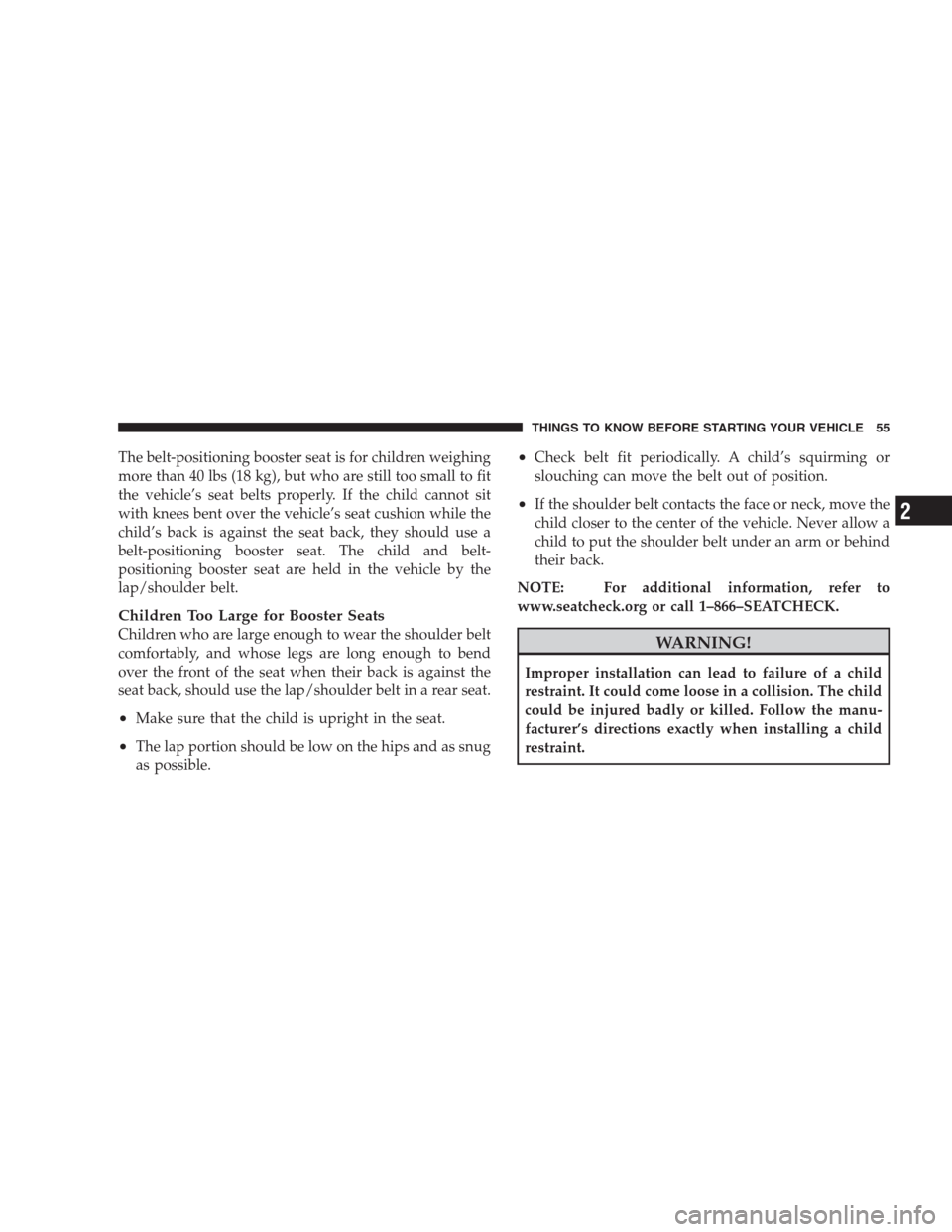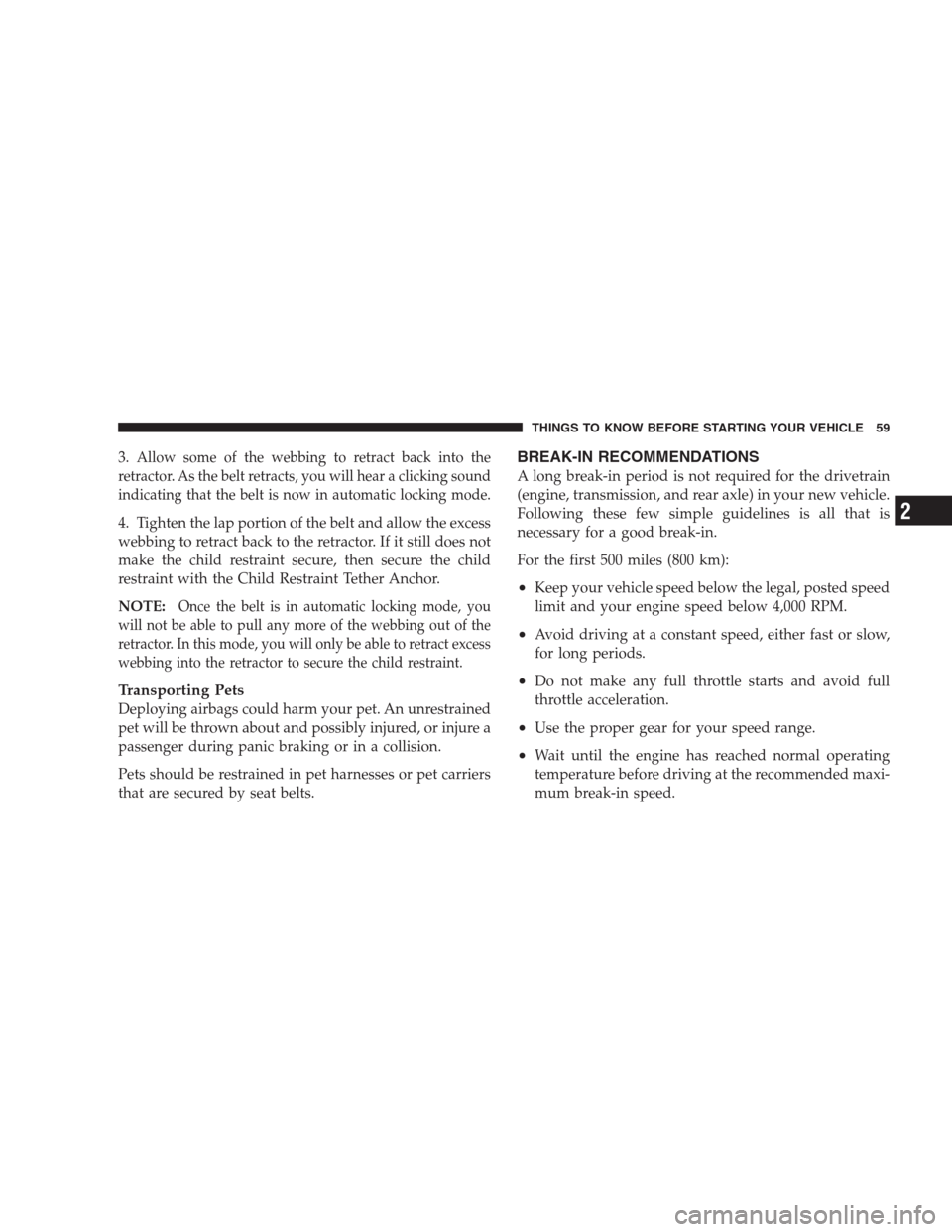Page 57 of 299

The belt-positioning booster seat is for children weighing
more than 40 lbs (18 kg), but who are still too small to fit
the vehicle’s seat belts properly. If the child cannot sit
with knees bent over the vehicle’s seat cushion while the
child’s back is against the seat back, they should use a
belt-positioning booster seat. The child and belt-
positioning booster seat are held in the vehicle by the
lap/shoulder belt.
Children Too Large for Booster Seats
Children who are large enough to wear the shoulder belt
comfortably, and whose legs are long enough to bend
over the front of the seat when their back is against the
seat back, should use the lap/shoulder belt in a rear seat.
•Make sure that the child is upright in the seat.
•The lap portion should be low on the hips and as snug
as possible.
•Check belt fit periodically. A child’s squirming or
slouching can move the belt out of position.
•If the shoulder belt contacts the face or neck, move the
child closer to the center of the vehicle. Never allow a
child to put the shoulder belt under an arm or behind
their back.
NOTE: For additional information, refer to
www.seatcheck.org or call 1–866–SEATCHECK.
WARNING!
Improper installation can lead to failure of a child
restraint. It could come loose in a collision. The child
could be injured badly or killed. Follow the manu-
facturer’s directions exactly when installing a child
restraint.
THINGS TO KNOW BEFORE STARTING YOUR VEHICLE 55
2
Page 58 of 299

Here are some tips on getting the most out of your child
restraint:
•Before buying any restraint system, make sure that it
has a label certifying that it meets all applicable Safety
Standards. We also recommend that you make sure
that you can install the child restraint in the vehicle
where you will use it before you buy it.
•The restraint must be appropriate for your child’s
weight and height. Check the label on the restraint for
weight and height limits.
•Carefully follow the instructions that come with the
restraint. If you install the restraint improperly, it may
not work when you need it.
•Buckle the child into the seat according to the child
restraint manufacturer’s directions.
•When your child restraint is not in use, secure it in the
vehicle with the seat belt or remove it from the vehicle.
Do not leave it loose in the vehicle. In a sudden stop or
collision, it could strike the occupants or seat backs
and cause serious personal injury.
Child Restraint Tether Anchor
Child restraints having tether straps and hooks
for connection to tether anchors have been
available for some time. In fact, many child
restraint manufacturers will provide add-on
tether-strap kits for some of their older products. There is
a tether strap anchor located behind the child tether
access cover behind the passenger seat.
To attach a child restraint tether strap:
1. Move the seat forward.
2. Move the seatback to its full forward position.
56 THINGS TO KNOW BEFORE STARTING YOUR VEHICLE
Page 60 of 299

7. Return the seatback to an upright position.
8. Install the child restraint according to the manufactur-
er’s directions.
9. Remove slack from the tether strap according to the
child restraint manufacturer’s directions.
WARNING!
An incorrectly anchored tether strap could lead to
increased head motion and possible injury to the
child. Use only the anchor position directly behind
the child seat to secure a child restraint top tether
strap.
Installing Child Restraints Using the Vehicle Seat
belt
The passenger seat belt is equipped with an automatic
locking retractor for child restraint system installation. It
is designed to keep the lap portion of the restraint held
tightly to the passenger seat. Seat belts equipped with
automatic locking retractors have a distinctive label on
the webbing. (Refer to “Automatic Locking Mode” in this
section for additional information).
To restrain the child seat:
1. Pull enough webbing from the retractor to allow the
belt to pass through the child restraint and insert the latch
plate into the buckle until you hear a “click.”
2. Grasp the shoulder portion of the belt and pull all of
the webbing out of the retractor.
58 THINGS TO KNOW BEFORE STARTING YOUR VEHICLE
Page 61 of 299

3.Allow some of the webbing to retract back into the
retractor. As the belt retracts, you will hear a clicking sound
indicating that the belt is now in automatic locking mode.
4. Tighten the lap portion of the belt and allow the excess
webbing to retract back to the retractor. If it still does not
make the child restraint secure, then secure the child
restraint with the Child Restraint Tether Anchor.
NOTE:
Once the belt is in automatic locking mode, you
will not be able to pull any more of the webbing out of the
retractor. In this mode, you will only be able to retract excess
webbing into the retractor to secure the child restraint.
Transporting Pets
Deploying airbags could harm your pet. An unrestrained
pet will be thrown about and possibly injured, or injure a
passenger during panic braking or in a collision.
Pets should be restrained in pet harnesses or pet carriers
that are secured by seat belts.
BREAK-IN RECOMMENDATIONS
A long break-in period is not required for the drivetrain
(engine, transmission, and rear axle) in your new vehicle.
Following these few simple guidelines is all that is
necessary for a good break-in.
For the first 500 miles (800 km):
•Keep your vehicle speed below the legal, posted speed
limit and your engine speed below 4,000 RPM.
•Avoid driving at a constant speed, either fast or slow,
for long periods.
•Do not make any full throttle starts and avoid full
throttle acceleration.
•Use the proper gear for your speed range.
•Wait until the engine has reached normal operating
temperature before driving at the recommended maxi-
mum break-in speed.
THINGS TO KNOW BEFORE STARTING YOUR VEHICLE 59
2
Page 63 of 299

mispositioned parts. Open seams or loose connections
could permit exhaust fumes to seep into the passenger
compartment. In addition, inspect the exhaust system
each time the vehicle is raised for lubrication or oil
change. Replace or adjust as required.
Safety Checks You Should Make Inside the
Vehicle
Seat Belts
Inspect the belt system periodically, checking for cuts,
frays and loose parts. Damaged parts must be replaced
immediately. Do not disassemble or modify the system.
Seat belt assemblies must be replaced after an accident if
they have been damaged (bent retractor, torn webbing,
etc.). If there is any question regarding belt or retractor
condition, replace the belt.
Airbag Warning Light
The light should come on and remain on for six to eight
seconds as a bulb check when the ignition switch is first
turned ON. If the light does not come on or flickers
during or after the six to eight seconds, or flickers or
comes on while driving, have the system checked by an
authorized dealer.
Defrosters
Check operation by selecting the defrost mode and place
the blower control on high speed. You should be able to
feel the air directed against the windshield. If the wind-
shield defroster is not working properly, have the system
checked as soon as possible by an authorized dealer.
THINGS TO KNOW BEFORE STARTING YOUR VEHICLE 61
2
Page 67 of 299
CONVERTIBLE TOP OPERATION — IF EQUIPPED
WARNING!
The convertible top does not provide the structural
protection that a reinforced metal roof does, and the
fabric top cannot be expected to prevent the ejection
of the occupants of a vehicle in a collision. Therefore,
it is important that all occupants wear their seat belts
at all times when riding in a convertible. Studies
have shown that during a collision it is generally
safer to remain inside a vehicle than to be ejected
from the vehicle.
CAUTION!
•To insure that no damage occurs, be sure that the
vehicle is at a complete stop with the shift lever in
the NEUTRAL position before lowering or raising
the top.
•Do not operate the convertible top with ice or
snow build up on the top. Damage to the top may
occur.
To Lower the Top
1. Lower the window in each door at least 1 in (2.5 cm).
2. Lower both sun visors.
UNDERSTANDING THE FEATURES OF YOUR VEHICLE 65
3
Page 82 of 299
WARNING!
•Adjusting a seat while the vehicle is moving is
dangerous. The sudden movement of the seat
could cause you to lose control. The seat belt might
not be properly adjusted and you could be injured.
Adjust the seat only while the vehicle is parked.
•Do not ride with the seatback reclined so that the
shoulder belt is no longer resting against your
chest. In a collision, you could slide under the seat
belt and be seriously or even fatally injured. Use
the recliner only when the vehicle is parked.
Recliner Adjustment
The recliner control is located on the outboard side of the
seat. To recline the seat, lean forward slightly, pull the
recliner control lever upward, lean backward until the
seat is in the desired position, and release the lever. To
return the seat to its full upright position, lean forward,pull the recliner control lever upward and hold it until
the seat returns to its full upright position.Recliner Control
80 UNDERSTANDING THE FEATURES OF YOUR VEHICLE
Page 109 of 299

WARNING!
Do not exceed 55 mph (88 km/h) if the LOW Tire
indicator is activated. Vehicle handling and braking
may be reduced. You could have an accident and be
severely or fatally injured.
Seat Belt Reminder Light
If the driver does not buckle their seat belt and
vehicle speed exceeds 5 mph (8 km/h), or if the
passenger does not buckle their seat belt within
10 seconds of vehicle speed exceeding 5 mph (8 km/h),
the Enhanced Warning System (BeltAlert�) will alert the
occupant(s) to buckle their seat belt(s). Once triggered,
the BeltAlert�will flash the Seat Belt Reminder Light and
chime for up to 96 seconds to alert the occupant(s) to
buckle their seat belt(s). If the driver unbuckles their seat
belt while vehicle speed is greater than 5 mph (8 km/h),or if the passenger unbuckles their seat belt for more than
10 seconds while vehicle speed is greater than 5 mph
(8 km/h), the BeltAlert�will reactivate.
Gauges and Indicator Lights
Tachometer
This gauge shows engine speed in revolutions-
per-minute (RPM) times 1,000. Avoid excessive
engine speeds in any part of the red warning
zone, particularly when driving downhill or in
lower gears.
Skip Shift Indicator Light
This indicator is located in the Tachometer. When
the indicator light turns amber, it means that you
are being prevented from shifting the transmission from
First to Second or to Third gear. When the indictor light
turns red, it means that the tachometer gauge pointer is at
UNDERSTANDING YOUR INSTRUMENT PANEL 107
4